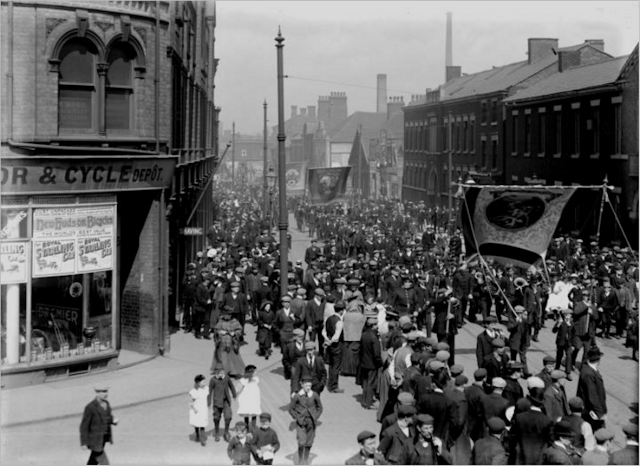THIS MOVEMENT has been operating in Staffordshire for hundreds of years.

Perhaps one of the oldest manifestations is The Abbots Bromley Horn Dance, thought to have originated in the pagan period when the ruling dynasty of Mercia (based Tamworth) owned extensive hunting lands surrounding Abbots Bromley. The royal forester choreographed magic rituals to ensure good hunting and as the tradition continued into Christian times it become a way to affirm the villagers' hunting rights.
 |
| Abbots Bromley Horn Dance. 1930 - 1939 (c.) Reproduced by kind permission of Staffordshire Achieves and Heritage Service |
Another movement with pagan origins is the Maypole Dance which has been appropriated by various causes. For example this 1911 dance in Walton-on-the-Hill, Stafford formed part of the Parish of Berkswich celebrations for the Coronation of King Geroge V and Queen Mary.
 |
Maypole Dance, Walton on the Hill 1911
Reproduced with kind permission of Martin Husselbee
|
 |
| Reproduced with kind permission of The Potteries Museum & Art Gallery |
 |
Keep Fit Class, Lotus Shoes, Stafford, 1924.
Reproduced by kind permission of Staffordshire Achieves and Heritage Service
|
Back in 1924 Stoke-on-Trent was one of several cities that refused dance licenses on 11 November at a time when there was a split of public opinion about whether Armistice Day should be one of celebration or mourning. The former eventually won out but here we see how movement becomes a site of political contest.
Movement is also a site of religious struggle, as demonstrated by the development of methodism in Staffordshire.
Primitive Methodism was a purist form of Methodism that broke away from the Wesleyan Methodist Church, It emerged in Staffordshire in 1811 from the merger of Hugh Bourne' 'Camp Meeting Methodists' and William Clowes's 'Clowesites'.
Clowes was born in Burslem in 1780. and up into his 20s he was an accomplished dancer, at a time when (according to his biographer William Garner) "the youth of both sexes exhausted their mental and physical powers in the light fantastic step and mazy dance. Scientific skill and practical expertness in this fashionable, unhealthy exercise, were regarded as fine accomplishments."
 |
| Extract from William Clowes's journal |
Nevertheless he continued to dance as part of his evangelism and his embodied knowledge no doubt shaped his involvement in the 'camp meeting' movement. Frowned up on mainstream Methodism, these day-long, open air meetings involving public praying, preaching and Love Feasts.
 |
| Methodist camp meeting (1819 engraving) |


No comments:
Post a Comment